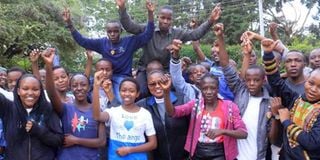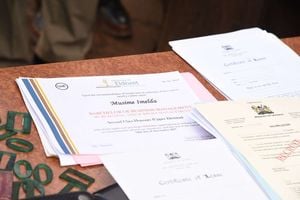All KCPE candidates to join Form One in free secondary plan

The administrator of St. Scholastica’s Catholic school Sister Emily Macharia celebrates with other teachers and top students Dan Laban Nyakweba Marube (right), 434) and Mark Nyakweba Birundu (left, 431) at their school on November 23, 2017. The school had a mean score of 376. PHOTO | JEFF ANGOTE | NATION MEDIA GROUP
What you need to know:
- With 993,718 pupils having sat KCPE, about 90,000 are likely to get slots in private schools.
- However, the students cannot be forced to join private schools.
All the 993,718 candidates who sat this year’s primary leaving examination are expected to join Form One when the free day secondary school education begins in January.
The government had targeted to have 903,200 students join public secondary schools and 100,356 enrol in private schools, going by the 1,003,556 pupils who registered for the 2017 Kenya Certificate of Primary Education (KCPE) examination.
Secondary school slots would, therefore, go up from last year’s 790,680, which means an extra stream is likely to be created to accommodate the increased enrolment.
TRANSITION
With 993,718 pupils having sat KCPE, about 90,000 are likely to get slots in private schools.
The transition rate from primary to secondary school was 83.93 per cent last year, when 942,021 sat the exam, but the government targets 100 per cent.
Early this year, national schools absorbed 24,795 KCPE candidates, extra-county schools 65,331, county schools 133,785, sub-county schools 492,576, special schools 1,449 and private schools 72,744.
While releasing the KCPE results on Tuesday, Education Cabinet Secretary Fred Matiang’i said the government had issued a circular outlining details of the planned programme, for which it has set aside Sh56 billion.
Every student in secondary school was allocated Sh22,244 annually, up from the current Sh12,870, to cater for tuition costs.
The government will also pay registration fees for national exams.
The capitation will be disbursed in the ratio of 50:30:20 in first, second and third term.
EXPENSES
For day scholars, the money will more or less cater for all their expenses as they will only be required to buy uniforms and lunch. Previously, they paid Sh9,374 a year per student.
“What this now means is that, from January, no child will be required to pay tuition fees in any public secondary school,” said Dr Matiang’i. “This must be seen as a big scale-up from the free day learning programme that has been running in all public secondary schools.”
However, boarders will continue to pay for accommodation, upkeep and other utilities in school.
In this context, national schools and extra-county schools in Nairobi, Mombasa, Nakuru, Kisumu and Eldoret will charge Sh53,554, while others will charge 40,535, and receive a Sh22,244 subsidy per student from the government.
The CS went on: “It is now clear that the Jubilee government is committed to ensure that every child gets access to education at all levels. We must not forget that the government now pays examination fees for candidates in all public and private primary and secondary schools.”
ROLLOUT
Teachers Service Commission chief executive officer Nancy Macharia said the current teachers will support the rollout of free secondary education.
Statistics indicate that there are about 88,000 post-primary teachers in the country with a shortage of about 50,000. However, Ms Macharia did not explain when more teachers will be recruited to plug the gap.
Schools must be ready with adequate classrooms, desks, chairs, laboratories and teachers to provide quality education.
A report by a task force chaired by Dr Kilemi Mwiria revealed that 37 per cent of teachers are employed by schools’ boards of management (BoMs). This means that parents will, once again, carry the burden of hiring teachers.
Kenya Union of Post-Primary Education Teachers (Kuppet) chairman Omboko Milemba said the government should hire more than 30,000 teachers to support the programme.
However, going by the data from Kenya National Examinations Council (Knec), about 236,668 candidates who scored below 200 marks could be ineligible for admission to secondary school.
EQUIPPED
Those are the candidates who eventually get placed in youth polytechnics, which the government has increased and equipped in recent years.
About 234,308 candidates obtained 101 marks to 200 marks out of 500 while 2,360 got less than 100 marks. The pass mark is 250 marks.
Data from the council indicate that performance in this year’s exam recorded a major improvement as the best candidate scored 455 marks, compared to last year’s 437 marks.
The CS attributed the improved performance to adequate preparation of the candidates by teachers under the new stringent examinations regime.
“I wish to commend teachers for this, especially given that they prepared the candidates in an election year that saw the country hold two presidential elections, with its attendant heated campaigns,” said Dr Matiang’i.
A report on school unrest in by career administrator Claire Omolo which was released in May revealed that most classrooms were congested, some with as many students as 65 students instead of 45.
“Class congestion seriously compromised the teacher-learner contact time and eroded the effectiveness of the teaching learning process,” said the report. “Learners’ grievances to the school administration included discomfort due to the congestion.”
FUNDING
Kenya Secondary School Heads Association chairman Kahi Indimuli said several schools had received funding to improve their infrastructure ahead of the free secondary education rollout.
“We will do our best to ensure that the students are comfortable but we hope schools that have not received funds will be given in due course so that they can put up more classrooms, buy desks and build laboratories,” said Mr Indimuli.
He, however, admitted that there will be congestion in schools unless the infrastructure was put in place on time.
Indeed, this came out forcefully in the Omolo report, which stated that boarding facilities were in horrible condition.
“Most schools lacked adequate toilets and had inappropriately located, poorly maintained sanitation facilities,” said the report. “Some had students bathing in the open, thereby compromising their security and privacy.”
Kenya Private School Heads Association chief executive officer Peter Ndoro said the schools are ready to receive the extra students that the government will allocate them.
“We have the capacity to absorb more students and complement the government’s target of expanding access to secondary education,” said Mr Ndoro.
However, the students cannot be forced to join private schools.





